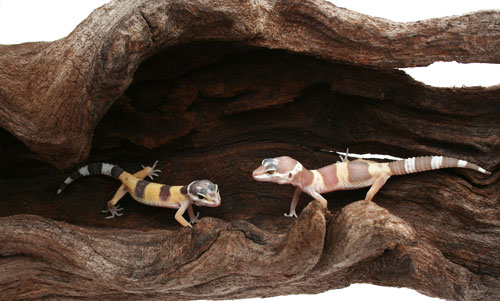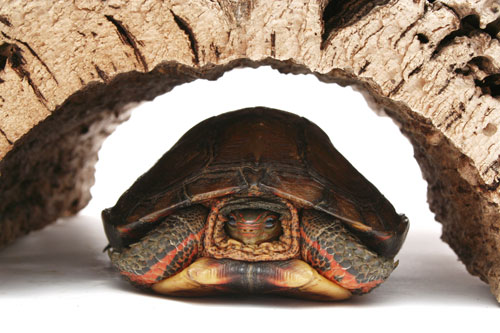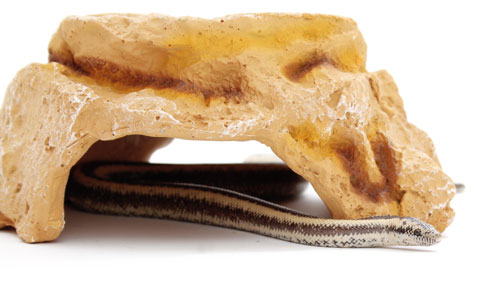Keep your reptiles healthy by providing a hiding spot for them.

One of the frustrations of reptile keepers: Reptiles like to hide. In fact, they tend to spend most of their day hidden from view. The result is that when you walk by the terrarium to peek at your pet, it's nowhere to be found. Some reptile keepers are tempted to remove hiding places from their herp's environment in order to make the animals more visible. However, this practice is not only stressful to the herp, but it can prove to be deadly.
Why Pet Reptiles Need Hiding Places
Although certain herp species have been kept in captivity for generations, their instinct to be wary of predators is still keen. Your reptile may never have come into contact with a larger animal, whose goal is to make a meal out of it, but its need to protect itself is just as acute as if in the wild. The most effective way for a herp to avoid coming in to contact with a predator is to conceal itself within the environment. If the predator doesn't spy the herp, the herp has a greater chance of being passed over as a meal.
"Hiding is a natural instinct in practically all species of animals, including reptiles," says Heidi Watkins, DVM, a veterinarian with a special interest in exotics, practicing in Yorba Linda, Calif. "They have the need to be unseen by potential predators, as well as members of their own kind, in some cases."

Photo by Gina Cioli/i5 Studio
A hollowed out log makes a good hide.
Most herps have two ways to avoid being eaten by something larger than themselves: running and hiding. Running is a last resort because it uses up the animal's valuable energy reserves and may ultimately prove to be fruitless. Hiding, on the other hand, does not require a lot of energy output and is far more effective than trying to flee once a predator is in pursuit. Hiding also helps reptiles avoid potentially dangerous battles with members of their own species. Many herps are territorial, and they will fight ferociously with another herp in order to maintain or gain turf. Even if your herp lives alone, it still has the instinct to stay concealed to avoid an attack from another reptile.

Photo by Gina Cioli/i5 Studio
Turtles need hides for good health.
Reptiles Hide For Health
Captive reptiles that are denied the option to conceal themselves are at great risk-not of being eaten by a predator or battling with a foe but of suffering poor health.
"Reptiles must always be on high alert for danger or confrontation," says Watkins. "This can be exhausting and stressful for the animal, and this will take its toll."
When reptiles-or any animal species-are under stress, the body suffers the consequences.
"Chronic stress can suppress the immune system, which helps fight off infections, such as respiratory, skin and systemic bacterial infections ," says Watkins, noting that reptiles deprived of hiding places can be plagued with a host of illness that may ultimately result in loss of the animal's life. Chronic stress also makes the herp more susceptible to parasites, which can kill an already-weakened animal.
Because reptiles suffering from chronic stress have reduced appetite, they can also suffer from nutritional deficiencies (/Reptile-Health/Ask-A-Vet/Constipated-Lizard/), says Watkins. This results in weight loss, decreased activity and more susceptibility to disease.
On the flip side, reptiles provided with a good hiding place feel secure. Their stress levels are lower, their immune systems are stronger and they tend to live longer.
Ground Cover Hides for Reptiles
Given the importance of hiding places, it's vital that every terrarium contain suitable areas where a herp can conceal itself. Fortunately for herp owners, a variety of options are available on the market.
The type of hiding place you choose for your pet will depend primarily on the type of herp you own. Terrestrial animals need secure cover located on the terrarium floor, while arboreal species prefer a hiding place higher up in the enclosure. The widest variety of commercially made hiding places is designed for terrestrial herps. Species that need hiding places on the ground include leopard geckos, iguanas, bearded dragons, anoles, fire-bellied toads and rosy boas, to name a few. When it comes to hiding, terrestrial herps prefer any object that will function as a makeshift cave. Different materials and designs are available from reptile product manufacturers, and as long as the animal feels secure and the hiding place is safe, any cave-type dwelling is acceptable.
When choosing a hiding place for your terrestrial herp, select one that is large enough to conceal the animal's entire body with an opening large enough for it to easily enter and exit, but not so large that the herp feels exposed. Some examples of cave-like hiding places include:
- "Natural" Dwellings. Hollowed-out logs, coconut shells, driftwood, animal skulls and stone structures are some natural-looking dwellings you can provide for your terrestrial herp. Although many commercial hides are made of natural products, others are constructed from resin, plastic and other synthetic materials, which makes them easier to clean. These types of dwellings are available in pet supply stores or online, and they come in a variety of styles and colors.
- Decorative Hides. A variety of manmade hiding places are available to herp owners who want to decorate their pet's terrarium with a theme, or even with some humor. As long as the hiding place is physically stable, has no sharp edges and provides security for the pet, any design will work. Some different decorative hideaways available include pyramids, skulls (dinosaur, pirate and cow, to name a few), tropical huts, castles, treasure chests, purses and shacks.
- Homemade Hideouts. Herp owners on a budget, or those who want to be creative, can make their own hides. Small cardboard boxes, Styrofoam cups cut in half, small paper bags, empty toilet paper rolls and colored plastic food containers with a doorway cut into them can all work, even though they may need to be replaced after a while. Homemade rock structures are also an option, provided that the rocks are securely glued together so they don't collapse on top of the reptile. Each of these items can be decorated to add a nice flair to the terrarium, as long as only non-toxic paint and glue is used. Hiding boxes that provide extra humidity are also a good homemade option for ground-dwelling herps that need a damp environment. The hide box can be made humid by crafting it from a plastic container (such as a margarine tub or a plastic food-storage container), and using a substrate that holds moisture, such as sphagnum moss or a commercially made, high-humidity material designed for use with reptiles.
- Deep Substrate. Terrestrial herps that like to burrow, such as certain snakes and lizards, can also benefit from substrate that is easy to dig through. Substrates created specifically for burrowing reptiles are available at pet supply stores or online. Burrowing animals should also have a terrestrial hiding place in addition to a substrate that allows them to take cover underground. Good burrowing substrates include clay and sand. Only use those made specifically for reptiles.
Arboreal Reptile Hides
Even though arboreal herps like to live up off the floor of the terrarium, they need a place to hide just as much as their terrestrial cousins. You can find seclusion for arboreal herps in various forms. Commonly kept species, such as green tree pythons, water dragons, emerald tree boas, tree frogs and day geckos, will all benefit from hiding places high up in their terrariums.
In the wild, arboreal herps live in trees and conceal themselves in the leaves of bushes and shrubbery. To help provide the most natural environment possible for these pets, many herpkeepers decorate the terrarium with clusters of large, leafy plants, either real or synthetic. Here, climbing herps can hide themselves among the leaves, as they would in nature, and feel secure.
Another hiding option for arboreal herps is a hide box that has been attached to the side of the terrarium at the level where the animal prefers to spend much of its time. The box can be made of light wood or cardboard, and it can be glued or affixed with screws into the terrarium's side.

Photo by Gina Cioli/i5 Studio
Commercial hides such as this cave make for easy cleaning.
More than One Hide for Your Herp
It's best for your herp if you offer it more than one hiding place. Offering it a choice is good for a few different reasons. The first has to do with terrarium climate. Herps need to be able to thermoregulate as needed. An animal with more than one hide can move to a cooler or warmer section of the enclosure without having to give up the security of a hide. One hide should be located near the terrarium heat source, and another should be placed on the opposite side of the enclosure, where it is cooler. This will give your herp a choice, depending on what it needs as far as temperature adjustment.
If you keep more than one herp in a terrarium, you have another reason to provide more than one hiding place. While some herps are content to squeeze into the same hide as their cage mates, others prefer to be alone. By offering more than one hide in a multi-pet terrarium, you give your herps plenty of opportunity to stay secluded in a way that they are most comfortable.
Keep your Amphibian Moist
If your herp is an amphibian, the hiding place you provide must include moisture. A soft, soil-type substrate in a section of the terrarium that has been covered in leaves will be a favorite hiding place for frogs and toads. Logs and small stacks of weathered wood can also provide cozy hiding spots for these animals. Try piling up some tree branches in a corner, allowing room underneath for the animal to hide. Just make sure they are positioned so they do not collapse on top of your pet.
Salamanders also require a hiding place, and they feel comfortable under logs, rocks or boards, as long as the environment is kept moist. Turtles enjoy hiding in brush or leaves located on the floor of the terrarium, or in wooden hide boxes that have a moist substrate underneath.
Where is My Reptile Hiding?
Hiding places are mandatory if you want a happy, healthy herp. On the other hand, providing a hiding place for your pet means that you'll be less likely to see it when walking past his terrarium. With a little creativity, you can offer a good spot for your pet to hide while at the same time, leaving it at least partially visible. One way to do this is to use creative decorating techniques as you set up your pet's terrarium. Hiding places situated on the bottom of the terrarium can be easily positioned along one side, so that you can see inside them when you look into the terrarium. Consider where you stand most often to observe your pet, and angle the hiding place so that you can easily see into it. Arrange the other items in your herp's tank, so they do not block your view of the hiding inhabitant.
For arboreal herps that like to hide high up in their vertical terrariums, leave the side of the hide box open that faces the glass. By doing this, you'll create a secure place that helps your herp feel comfortable while still allowing you to be able to observe it. You can also position leaves in a way that allows you to see into the opening of the greenery.
By providing your herp with protected places to hide, you can rest assured that you are providing for both of your needs, and will have a happy and healthy pet for many years to come. REPTILES
Audrey Pavia is a freelance writer specializing in animal subjects. She is the author of The Gecko: An Owner's Guide to a Happy Healthy Pet and has contributed articles to both REPTILES and Reptiles USA. She has kept various herps, including geckos, corn snakes and tortoises.


